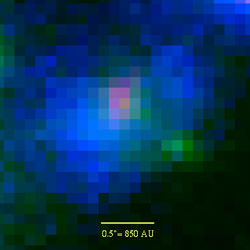
The centre of this infrared image shows the higher mass primary star (pink) and its lower mass companion. Image credit: CfA. Click to enlarge.
Newborn stars are difficult to photograph. They tend to hide in the nebulous stellar nurseries where they formed, enshrouded by thick layers of dust. Now, Smithsonian astronomer T.K. Sridharan (Harvard-Smithsonian Center for Astrophysics) and his colleagues have photographed a pair of stellar twins in infrared light, which penetrates the dust. And these babies are whoppers, weighing several times the mass of the Sun.
Moreover, Sridharan’s images reveal a circumstellar disk surrounding the more massive of the two stars. The presence of a disk suggests that massive, multiple-star systems form the same way as the Sun, by gradually accreting material from a gaseous disk.
“This system is the youngest massive binary ever to be directly imaged – only about 100,000 years old,” said Sridharan.
Sridharan and his colleagues studied an object known as IRAS 20126+4104, located more than 5,000 light-years away in the constellation Cygnus the Swan. IRAS 20126+4104 was suspected of harboring a binary star because outflows from the region wobbled back and forth like a spinning top. The wobble hinted at the gravitational tug of an unseen companion.
On several exceptionally clear and steady nights, the researchers were able to take highly detailed infrared images of this object using the UKIRT telescope on Mauna Kea, Hawaii. Those images revealed not one but two stars, as well as a dark dust lane where the inner parts of the disk, known from previous radio-wavelength observations, appeared nearly edge-on in silhouette.
“Many people have seen the iconic Hubble Space Telescope images of circumstellar disks around low-mass stars. This image is the equivalent for high-mass stars,” said Sridharan.
Between them the two stars weigh more than 10 times the mass of the Sun. Sridharan calculates that the surrounding disk contains at least one-tenth of a solar mass, which is enough material to make 100 Jupiter-sized worlds. The disk may be even more massive. It extends outward for at least 850 astronomical units, or 80 billion miles (more than 20 times the distance to Pluto). Interestingly, the smaller companion star currently is located at the same distance from the primary star, hinting that the companion’s gravity may play a role in limiting the outer reaches of the disk.
Sridharan said that the next step in studying this intriguing twin system is to get higher-resolution observations using adaptive optics or interferometry. Such data will yield a better estimate of the companion’s mass and a detailed profile of the disk.
“We are currently following several leads to investigate this star system, so stay tuned,” Sridharan added.
Sridharan’s co-authors are S.J. Williams and G.A. Fuller of UMIST (Manchester, UK). This research was published in the Sept. 20, 2005, issue of The Astrophysical Journal Letters and is available online at http://arxiv.org/abs/astro-ph/0508342.
Headquartered in Cambridge, Mass., the Harvard-Smithsonian Center for Astrophysics (CfA) is a joint collaboration between the Smithsonian Astrophysical Observatory and the Harvard College Observatory. CfA scientists, organized into six research divisions, study the origin, evolution and ultimate fate of the universe.
Original Source: Harvard CfA News Release
